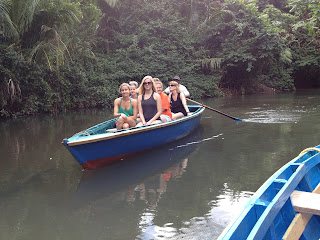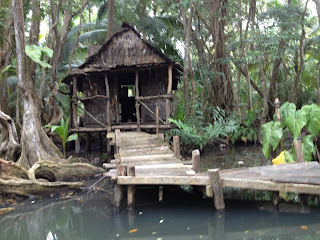Here is the second installment of answers to questions posed to me by a school in my hometown, which I have been paired with through the Peace Corps' World Wise Schools program. The original comments are shown below in italics, and then I broke out the questions individually further below.
Hi from us. The breadfruit tree sounds neat, but what does it taste like? Do you like it? Are all the gas-stations triangle-shaped? Do you have Wayside School books in your library? What is your favorite book to read? Grade 3A
Hello! What’s the craziest thing you have ever done in Dominica? Do you have any sailboats? Do you have storm shelters? Do you ever miss Parkersburg? What were you eating when you saw the rainbow bridge? You said you were eating something then, and we wondered what it was. The food looks pretty cool. Also, do you know how long it has been since one of the volcanoes erupted? Grade 4A
Hi! It is unbelievably beautiful there. Bet that spiky tree just wanted a hug. Have you seen any sharks or weird sea creatures? What was at the carnival? Are there any legends or myths there? There is a legend of a ghost at our school. Grade 5A
Have you seen any sharks or weird sea creatures? No sharks, and I hope I don't see any near our beach. The times I've taken my snorkel to our beach, I haven't really seen anything other than some small fish. Perhaps if I ventured over closer to the rocks I might see more underwater life, but I've mostly stayed in the middle of the beach area when snorkeling—I don't want the waves to push me against the rocks.
Hopefully I will get to do some snorkeling in better locations for seeing interesting sea life and will report on it at a later date. Some of last year's Peace Corps volunteers have seen some beautiful fish and other stuff when they have snorkeled at other locations.
I do know that our beach area is also a turtle nesting area, but I have not seen any turtles myself yet. Someone found an eggshell and it looks very much like a ping-pong ball. I have seen lots of crabs in the area, and I also enjoy watching the pelicans “dive-bomb” for fish. Plus, I enjoy checking out whatever fish our local fisherman catches when he gets back home from his fishing trips.
What was at the carnival? The carnival I wrote about that I saw on the island of St. Lucia certainly wasn't like the carnival at City Park on the 4th of July. In the Caribbean, “Carnival” is essentially a long parade of people who dress up in fancy costumes and dance their way into the middle of town. It comes from the same tradition that New Orleans has each year, but they call it Mardi Gras and hold it just before Ash Wednesday. However, in the Caribbean, different islands decided to space out their Carnival celebrations so that they would not all be held at the same time (thus potentially garnering more tourists).
Are there any legends or myths there? There is a legend of a ghost at our school. Yes, I have heard about the ghost at your school, because I remember that someone did a project for either the social studies or science fair about it last year. One myth I've heard down here is that if you take an Easter egg and keep it under your armpit for some period of time (a month?), it will hatch into some sort of little genie that can grant wishes for you. [Personally, I think it would be hard to keep an Easter egg in my armpit for that long, so I won't be testing this myth.]
The breadfruit tree sounds neat, but what does it taste like? Do you like it? Yes, I enjoy eating breadfruit. It is very common down here, and is used in a lot of dishes. It grows on trees and looks sort of like a green cantaloupe (but weighs less than a cantaloupe). You cut the skin off of it and then slice it up. The taste is somewhat bland, but it has an interesting, light texture.
My favorite way to have breadfruit is when it has been roasted on an open fire. They basically just build a small campfire and put the green breadfruit on top to burn. The blackened outer peel is cut away (see picture below), leaving a smokey flavored form of breadfruit to eat.
Are all the gas-stations triangle-shaped? No, that is the only one I've seen like that. Here is another picture of it. I think it is pretty neat.
Do you have Wayside School books in your library? What is your favorite book to read? I'm not sure about Wayside School books, but I will check and get back to you on that. My favorite books to read are non-fiction books. I enjoy learning while I read. I firmly believe that my interest in reading non-fiction as a youngster was key to my academic success. I still find myself sometimes using facts that I know I first learned from reading non-fiction books in elementary school and beyond.
I especially enjoy reading biographies (and autobiographies) because I can learn tips for living my life by understanding how someone else lived their life. I read a lot of books about explorers and presidents, as well as other famous people, many of them from a series for young readers called “Landmark Books.”
I also enjoy history (especially about the Civil War) and science books. I can remember reading a fantastic book about helicopters that essentially taught me how to fly one. I have never had the opportunity to test my helicopter flying skills, but whenever I've seen one at an airshow or something, I've been able to quickly identify the basic control mechanisms in the cockpit that would enable me to give it a try.
Back in the 1990s, I was a Read Aloud volunteer at your school. I can remember that I enjoyed reading biographies for children written by Robert Quackenbush, and also excerpts from Paul Harvey books. If you haven't discovered the joy of non-fiction, I would encourage you to give it a try. By the way, I re-organized our school's library to emphasize the non-fiction books that we have available.
What’s the craziest thing you have ever done in Dominica?
Well, I've eaten a lot of crazy new foods that I had never eaten before. For example, I've eaten pigs feet, pig snout, and pig tail (pig tail is probably the best, although I also like the smoked pigs feet in a clear broth that is considered a delicacy down here). I've also eaten sea snails (known locally as bwego) which were good. They also make a fried bread patty that is stuffed with minnows about an inch long. It is spiced up and reminds me just a bit of eating a crabcake (but try not to look at the minnows when you are eating it).
Do you have any sailboats? There are sailboats that I have seen down here, especially on the calmer Caribbean Sea on our western coast. No one in my village has one, and I have not seen many sailing near my village along the Atlantic.
Do you have storm shelters? There are no formal storm shelters that I am aware of, but I've certainly taken shelter from sudden rainstorms on porches and under overhanging roofs along the road. The cottage I live in is made of concrete, so it should be safe from any hurricanes.
Do you ever miss Parkersburg? I certainly miss seeing my family members, but the good news is that with today's technology, we are able to have videoconference calls to stay in touch via the Internet. However, I'm having a very good time down here. It seems that every day I learn something new, and I've always enjoyed learning new things.
I told the local newspaper reporter that I miss JR's Donut Castle and Pizza Place, too. Plus you can't get pepperoni rolls anywhere down here! I'm hoping to be able to return for a vacation next summer in conjunction with my high school reunion, and I will definitely be eating some local foods while I am there.
Finally, I miss stopping by your school each week for the Homework Helpers program in the cafeteria!
What were you eating when you saw the rainbow bridge? You said you were eating something then, and we wondered what it was. The food looks pretty cool. I don't recall exactly what I was eating that day. I am fortunate that my host family, my landlord, and others often share their food with me. If I'm cooking for myself, it is often just macaroni and cheese or ramen noodles. I've also discovered that ketchup goes with everything (especially if it is ketchup with your name on it--see beiow).

Stoves here use gas bottles such as camping trailers use. In order to stretch my gas as long as I can, I've been cooking two things at once. For example, if I making hard-boiled eggs, I put a metal strainer on top of the pot and heat up some leftovers or something. The steam from the boiling water goes up through the strainer and heats up the leftovers, allowing me to accomplish two tasks with half of the gas. Sometimes I've spooned out the boiled eggs, and then reused the same hot water to make ramen noodles, which saves even more gas.
Here is an example of my kitchen skills (or lack thereof). A former teacher (and grandmother to one of my current students) recently gave me some avocados, which they call pears. I have nothing against avocados, but they were starting to get soft and slimy, which is how I least enjoy them. I had recently been exposed by my host family to a dish where avocados are mixed with farina (a grain cereal sort of like Cream of Wheat) to form green balls that are eaten by hand. I couldn't find farina at the Sav-A-Lot grocery store in the capital, but I did find some finely ground whole oats from a mill in England that has been in business since 1675. I thought that might also work. Well, it was okay, but too paste-like to roll into balls. I ended up just eating it plain or using it as a sandwich spread.
Also, do you know how long it has been since one of the volcanoes erupted? There has not been a volcanic eruption here since it was first visited by Christopher Columbus. We do have a number of hot springs and other signs of volcanic activity below the surface of the earth here. Also, please see my answer to the first set of questions about the nearby island of Montserrat.
While I was on St. Lucia, there were warnings issued because an underwater volcano just north of Grenada named “Kick'em Jenny” was becoming active again. It is building under the water, but has not reached the surface yet. However, it is releasing lots of hot gases as it expands, which form a tremendous amount of bubbles. The warnings were for boats to stay out of that area of the sea. The danger is that seawater with lots of bubbles is not as buoyant as regular seawater. Thus, boats tend to ride lower in the water and the danger is that they might take on water and then sink. I certainly would not want to sink above an underwater volcano!

















































